What is Helium? A Guide to the DePIN Project Earning Through Network Infrastructure – Understanding its Ecosystem and SubDAOs
2024.10.18
- Project Research
- DePIN

Writer
Pacific Meta
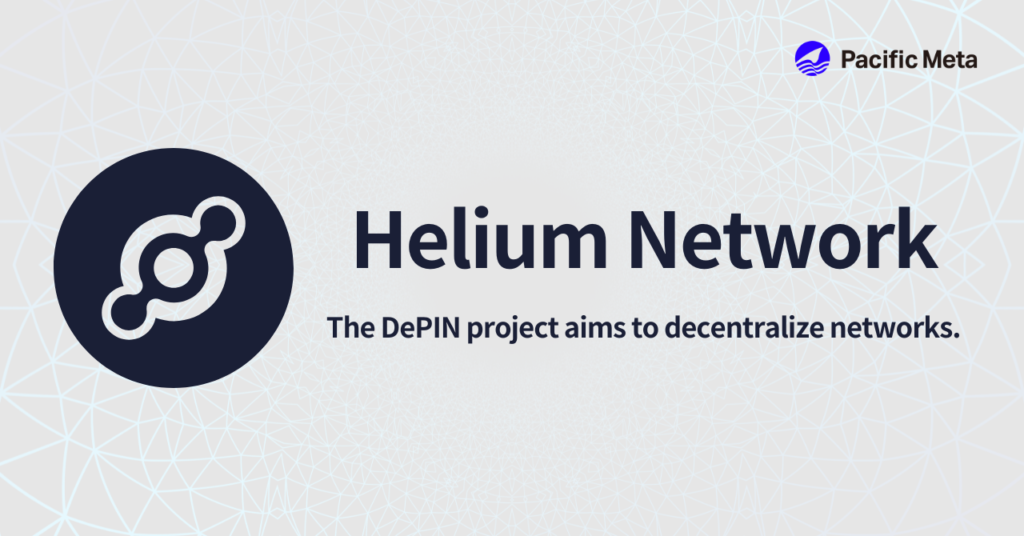
Over the past year, DePIN projects have garnered significant attention. Among them, Helium stands out as one of the most prominent projects, and today, we’ll be diving into its details.
Helium is a project focused on decentralizing networks, allowing individuals to earn by deploying specialized devices.
Helium offers competitive pricing compared to existing services and has expanded its network for IoT and mobile use, particularly across Europe and the U.S.
In this article, we will cover the following aspects of Helium:
Additionally, Pacific Meta distributes a newsletter for companies engaged in Web3 business.
Based on the expertise gained from supporting over 100 projects, we deliver the latest information on the Web3 industry, case studies, and other helpful insights to address your challenges.
➡ Subscribe to Pacific Meta’s newsletter
Challenges of Centralized Communication Services
The internet has become essential to our daily lives, but current centralized network systems face several challenges.
First, the cost of accessing network services for users is far from cheap. For example, unlimited mobile plans in the U.S. are priced around $70 per month.
Although low-cost SIM options exist, the U.S. market is known for offering relatively expensive data plans compared to more competitive regions like Japan.
The high cost of network services is partly due to the significant financial investment required to establish and maintain base stations and towers for telecom companies.
Moreover, in rural areas, high-quality network services are often unavailable because they are not financially viable for providers to offer.
For network operators, expanding existing infrastructure takes time and money, and upgrading to next-generation technologies like 5G requires substantial investment and long-term planning.
Helium aims to address these challenges posed by traditional network infrastructure.
Overview of Helium
Helium was founded in 2013 by Amir Haleem with the goal of providing efficient and low-cost network services.

Helium operates by encouraging individuals to set up “hotspot” devices, which decentralized network management and operations, allowing a broader and more cost-effective network service.
Not only do users benefit from access to a low-cost network, but they can also earn Helium tokens by deploying hotspots.
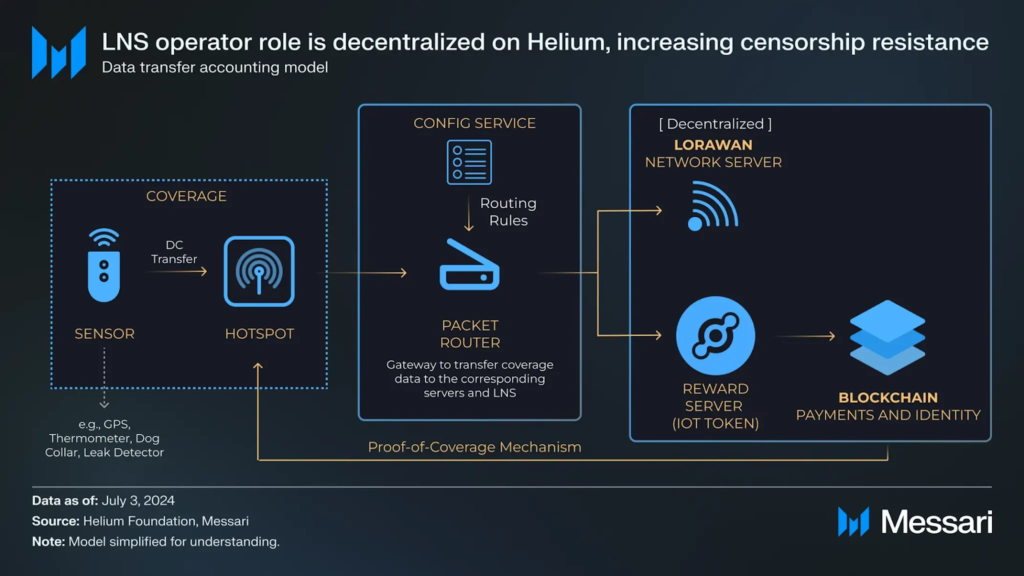
These hotspots collect coverage data (signal range information), which is transmitted to the central server and LNS (LoRaWAN Network Server).
The Helium protocol manages and analyzes the data, and users who manage the hotspots are rewarded with tokens based on their coverage contribution.
This type of Web3 project, which requires physical infrastructure, is categorized as DePIN. Helium has become one of the leading DePIN projects since mid-2023.
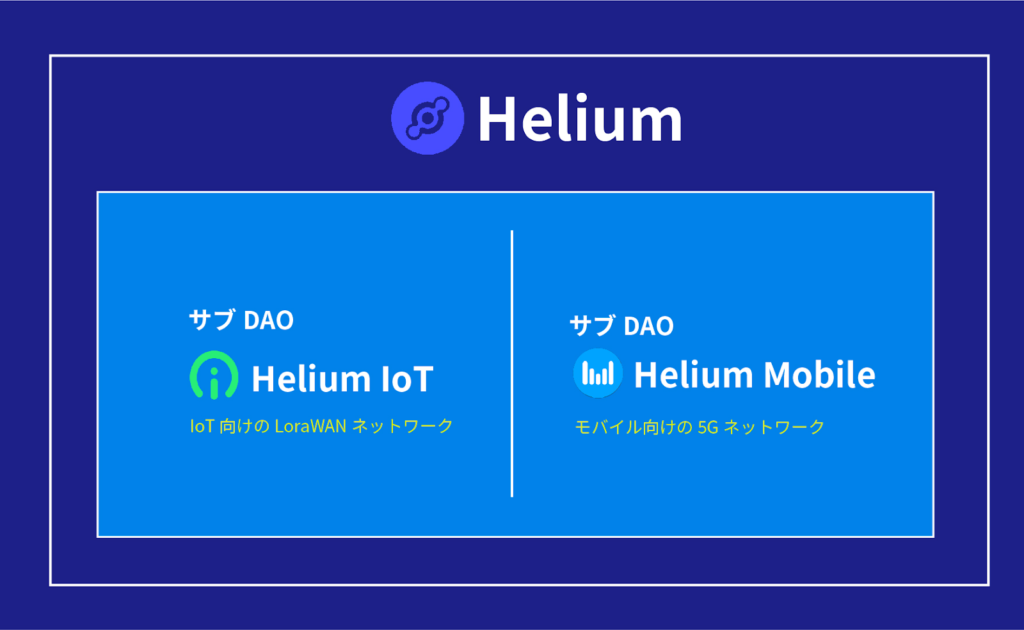
Helium currently operates two distinct networks:
- Helium IoT: A decentralized network using LoRaWAN to provide long-range communication between IoT devices with low power consumption.
- Helium Mobile: Helium’s primary network, offering decentralized 5G infrastructure for mobile services.
These are known as subDAO networks, each with its governance and economic systems, supporting the broader Helium ecosystem.
Details of these subDAOs and their tokenomics are explained later in the article.
Evolution of the Helium Ecosystem
Here, we’ll cover the major milestones in Helium’s journey up to 2024.
– 2013: Launch of the Helium Blockchain
Helium began by building a LoRaWAN protocol for IoT devices using its own blockchain. The network rewarded users running hotspots with HNT tokens through a mechanism called Proof of Coverage (PoC).
By converting HNT tokens into a secondary token called Data Credits (DC), users could pay for network services, ensuring the sustainability of the network’s economy.
This innovation paved the way for the creation of the current 5G network infrastructure, which Helium Mobile now operates on.
– 2022: Creation of SubDAO Networks
In 2022, Helium introduced subDAO networks, marking a significant evolution for the ecosystem.
Helium expanded beyond an IoT network by establishing several sub-networks, including 5G, under its umbrella. Each subDAO operates independently with its own governance and token systems, but all contribute to the Helium ecosystem.
– 2023: Transition to Solana
In April 2023, Helium transitioned from its proprietary chain to the Solana blockchain to meet growing demands and enhance usability as the subDAO strategy expanded.
With this transition, HNT tokens and MOBILE tokens for the 5G network began operating on Solana, with new hotspot management rights issued as NFTs on the Solana blockchain.
Meanwhile, the LoRaWAN-based Helium IoT network continues to operate on the original chain, though rewards have shifted from HNT to IOT tokens.
What are SubDAO Networks?
SubDAO networks are an essential component of the Helium ecosystem.
A subDAO operates as an independent decentralized network under the larger Helium DAO. Think of Helium as the main organization, with various subDAOs managing specific decentralized protocols. Each subDAO has its governance and economic system, providing greater flexibility in network management.
Details of Helium IoT
Helium IoT is a decentralized network infrastructure for IoT devices, utilizing LoRaWAN since Helium’s inception in 2013. LoRaWAN is a network standard that provides long-range communication with low power consumption, ideal for IoT.
Users deploy hotspots to decentralize network management. These hotspots provide long-range, low-power network coverage, and users are rewarded with IOT tokens via PoC, confirming network coverage.
IOT tokens can be staked on the Helium network to earn veIOT tokens, granting governance rights within the subDAO.
Details of Helium Mobile
Helium Mobile is a newer subDAO, established in 2022, and aims to build a future mobile network where 5G hotspots coexist with large telecom providers.

Helium Mobile offers users an affordable $20/month plan for unlimited data, calls, and texts, with no contract required. This network is accessible on devices compatible with U.S. frequency bands.
In 2022, Helium partnered with U.S. telecom giant T-Mobile, allowing users to switch to T-Mobile’s network in areas with limited Helium coverage via a virtual mobile network operator (MVNO) system.
This partnership has enabled Helium Mobile to expand its service across a broader area.
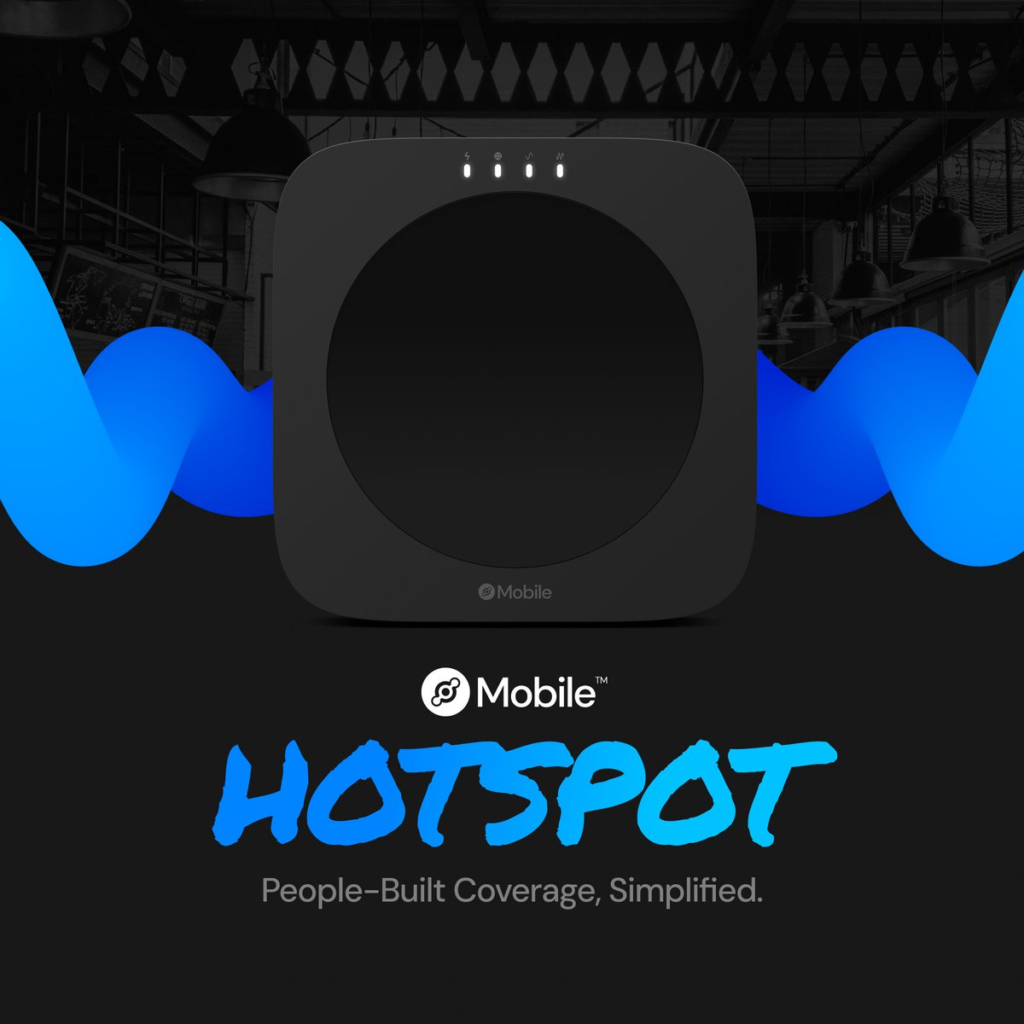
Like Helium IoT, hotspot owners on Helium Mobile are rewarded with tokens, but here the rewards are paid in MOBILE tokens, funded by the network’s user revenues.
Helium Mobile introduced “Discovery Mapping” in July 2023, allowing users to share their location data to verify hotspot coverage and identify gaps. Participants in this system earn additional MOBILE tokens, supporting the continued growth of Helium’s decentralized mobile network.
Helium’s Tokenomics
The Helium network uses three main tokens:
– HNT: The primary token for the Helium network, used to reward operators of IoT and mobile networks.
– IOT: The token for the Helium IoT subDAO.
– MOBILE: The token for the Helium Mobile subDAO.
Here’s a breakdown of their roles and functions:
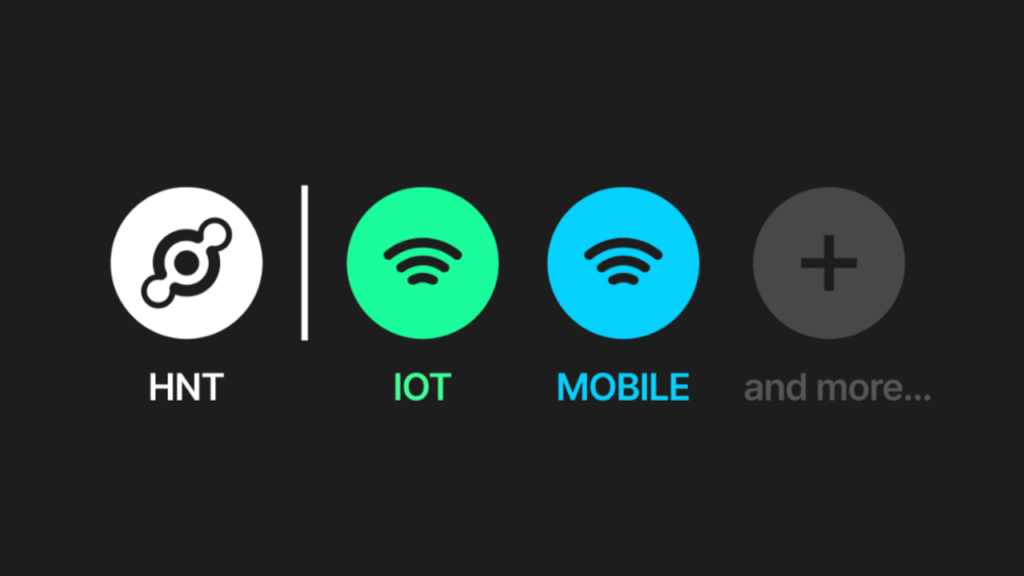
Helium Network Token (HNT)
HNT is Helium’s core token, with a maximum supply of 223 million HNT, reduced to 213 million through token burns. The current supply is around 169 million, as of the latest halving cycle.
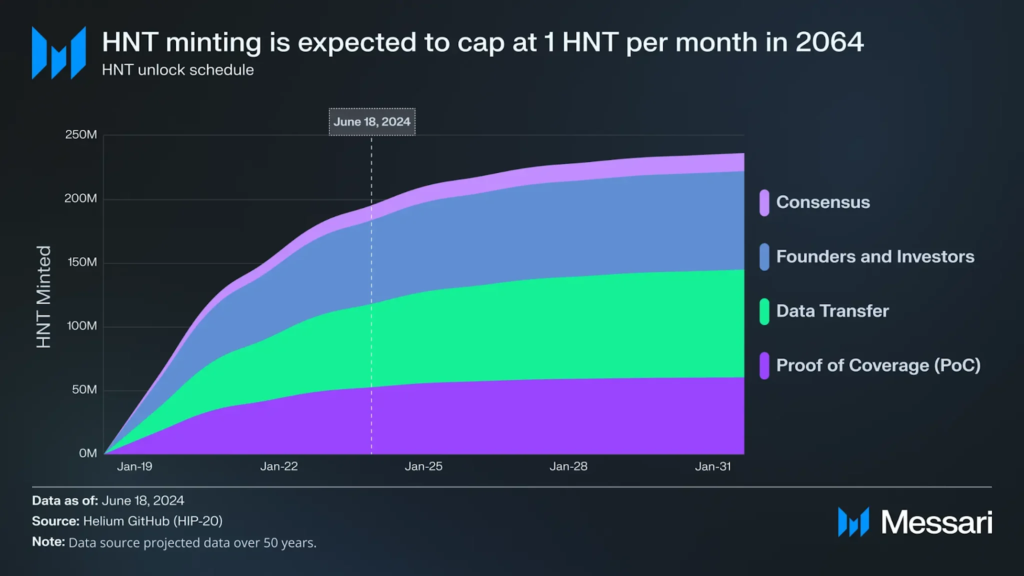
HNT serves three main functions:
1. Generating Data Credits (DC): HNT can be burned and converted into DC for paying network fees and data transfer costs.
2. Governance: HNT can be staked to receive veHNT, granting governance rights within Helium DAO.
3. Reward Distribution: HNT is distributed to subDAOs based on utility scores and can be converted into subDAO tokens.
Burn-and-Mint Mechanisms
Helium’s tokenomics are based on a burn-and-mint equilibrium. HNT is burned to generate DC, balancing network usage with token supply. As network demand increases, HNT supply decreases, raising its value.
Data Credits (DC)
DC is a non-transferable token used to pay for data transfer within the Helium network. It is pegged to USD, with 1 DC equivalent to $0.00001.
IoT devices consume 1 DC per 24 bytes of data transferred, and the mobile network charges 50,000 DC ($0.50) per GB.
DC is also used to deploy and manage devices on the network.
SubDAO Tokens (IOT and MOBILE)
Each subDAO operates within its ecosystem, using different tokens for rewards and governance.
– IOT Token: The token for Helium IoT, earned as a reward for managing LoRaWAN hotspots. Users earn IOT tokens via PoC and can convert them to HNT for generating DC
or staking for veIOT, which provides governance rights.
– MOBILE Token: The token for Helium Mobile, earned for managing 5G hotspots and WiFi networks. MOBILE tokens can also be converted into HNT for DC generation or staked for veMOBILE, granting governance rights.
Helium Network Usage
Helium has established decentralized wireless networks for both IoT devices and 5G services. Let’s take a look at how these networks are being utilized.
Helium IoT Usage
As of September 2024, Helium IoT has deployed over 350,000 hotspots, with significant coverage in urban areas across the U.S. and Europe.
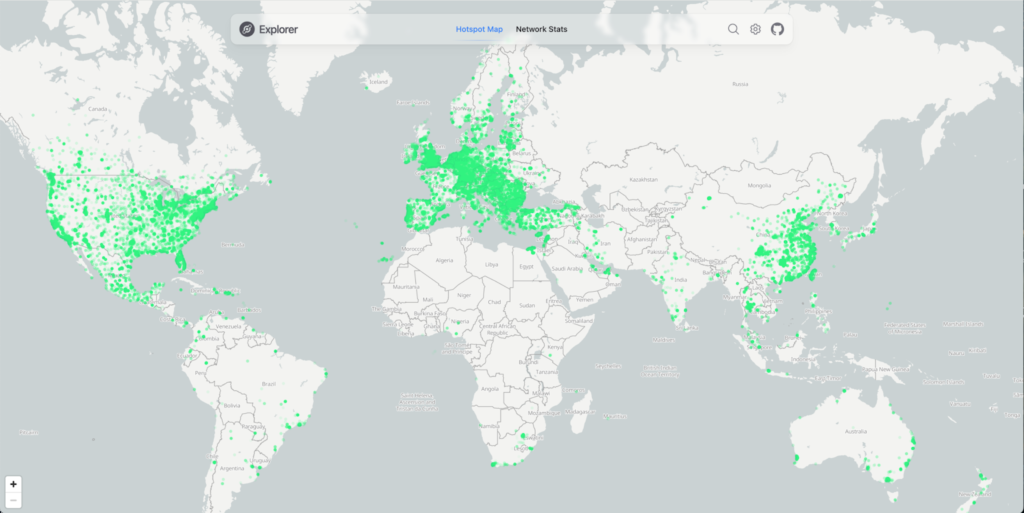

However, despite the large number of hotspots, demand for network usage is still relatively low. Currently, IoT usage accounts for only about 3-4% of Helium’s total network activity.
Helium Mobile Usage

Helium Mobile, introduced in 2023, offers a highly competitive service in the U.S. market with its $20/month unlimited plan.
The blue section in the graph above represents the revenue from Helium network transactions, showing that the majority comes from Helium Mobile.

Although there are only around 20,000 Helium Mobile hotspots, they account for over 95% of Helium’s total network activity, making Helium’s mobile network its primary service.
Summary of Helium
Helium is a leading DePIN project, expanding its IoT and 5G networks in urban areas across the U.S. and Europe.
Despite challenges such as regulatory hurdles for 5G infrastructure deployment and reliance on T-Mobile’s network for coverage, Helium is one of the few projects successfully competing with centralized network services.
While Helium has yet to launch in Japan, it could face legal restrictions under laws such as the Payment Services Act, the Radio Act, and the Telecommunications Business Act. Overcoming these legal requirements may allow us to see Helium hotspots in Japan in the future.
Additionally, Pacific Meta distributes a newsletter for companies engaged in Web3 business.
Based on the expertise gained from supporting over 100 projects, we deliver the latest information on the Web3 industry, case studies, and other helpful insights to address your challenges.

